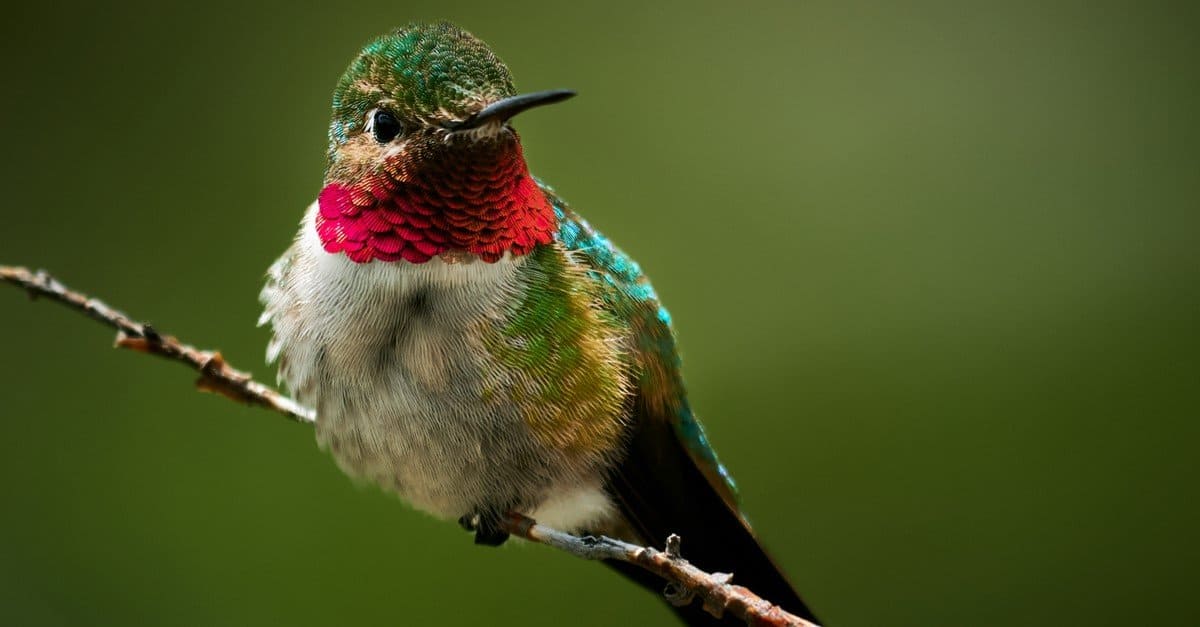Here we delve into the intriguing world of hummingbirds and their migratory patterns in Mississippi. Uncover the precise timing when these enchanting creatures bid farewell to the state, as well as unravel the secrets of their mysterious destinations. Prepare to embark on an awe-inspiring journey through nature’s wonders!
Types of Hummingbirds in Mississippi
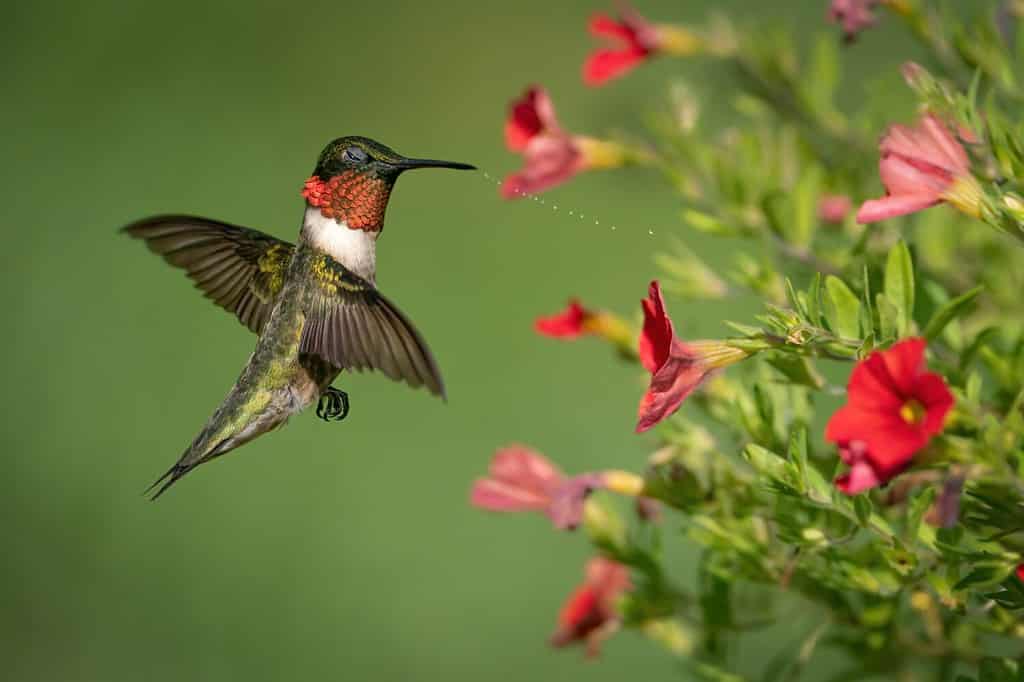
In Mississippi, the ruby-throated
hummingbird
arrives in spring to enjoy the blooming flowers.
©Cavan-Images/Shutterstock.com
Ruby-throated hummingbirds live in Mississippi during the summer and stick around to enjoy the heat and have beautiful hummingbird babies. There have been a few other types of hummingbirds spotted as they travel through the state, but the ruby-throated hummingbird is the only long-term resident.
When Do Hummingbirds Arrive in Mississippi?
Depending on the year, hummingbirds usually arrive in Mississippi sometime between late February and early March. During this time, they are looking to take advantage of the warmer climate and feed off of flowering plants. To help attract them to your yard, consider planting flowers that produce nectar along with providing a source of fresh water.=
When Do Hummingbirds Leave Mississippi?
The majority of hummingbirds that migrate to Mississippi tend to stay around until October or November, when it’s time for them to begin their journey southward for the winter months.
While many birds may leave in small waves throughout autumn as temperatures drop, large numbers of ruby-throated hummingbirds will usually wait until a big cold front passes through before they take off en masse.
Hummingbirds in Mississippi: Where Do They Go?
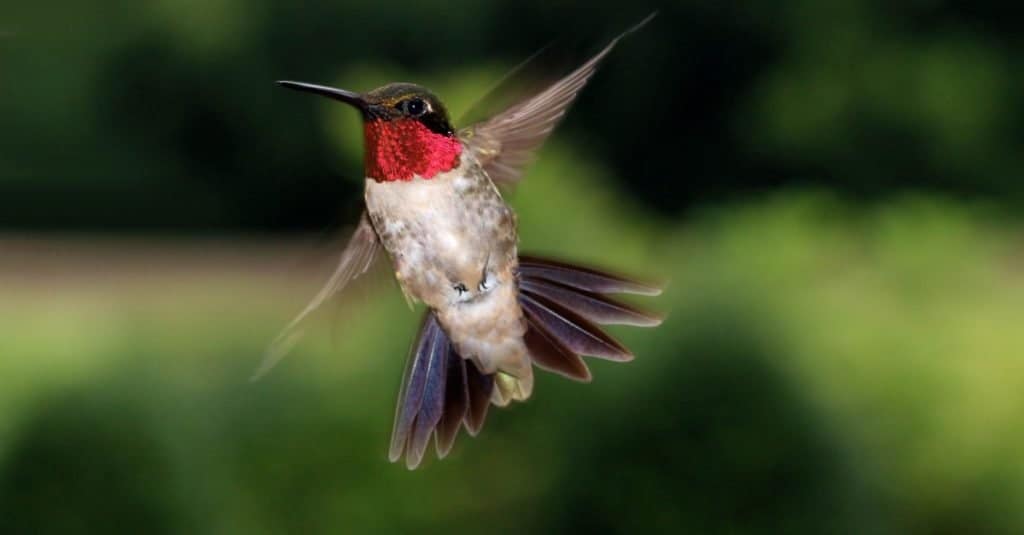
The male ruby-throated hummingbird has a bright red throat patch.
©Ramona Edwards/Shutterstock.com
Ruby-throated Hummingbirds migrate south through the United States, then cross the Gulf of Mexico to reach their wintering grounds in Central America and northern South America. Some hummingbirds may also stay on the southern fringes of North America for the winter months, including parts of Florida and Texas.
The migration route these hummingbirds take is incredibly long. Some birds may fly up to 2,000 miles or more from Mississippi all the way down to Panama! As they travel, they stop to rest and feed in various locations along the way. They favor areas where wildflowers are plentiful, as these provide an excellent source of nectar for energy.
The journey is dangerous for hummingbirds, and many do not survive it. The birds must battle strong winds, storms, predators, and exhaustion. To make their trip easier, they often take advantage of favorable winds or fly at night when temperatures drop, and air currents become more stable.
How Do Hummingbirds Prepare for Migration?

Female ruby-throated hummingbirds have their babies in Mississippi in the summer.
©Agnieszka Bacal/Shutterstock.com
Hummingbirds that are planning to migrate south must prepare for the long journey ahead. They can do this by eating large amounts of food in order to build up fat stores, which will help them make it through the trip. They know that they will be flying between 20 and 23 miles each day, so they take preparations very seriously.
In addition, hummingbirds may also use geomagnetic cues and visual landmarks such as mountains and rivers to orient themselves during migration. By using these natural resources, they can ensure they’re heading in the right direction and save energy along their travels.
How Long Does it Take for Hummingbirds in Mississippi to Prepare for Migration?
Migrating hummingbirds typically begin preparing for their journey in late summer or early fall. The exact amount of time it takes for a hummingbird to prepare for migration depends on the species, but most birds need about two weeks before they’re ready to leave. During this time, they feed heavily and rest as much as possible so that they can make it through the long flights ahead.
Once a hummingbird is ready to depart, its flight may take several days or even weeks, depending on the destination. The distance they need to travel could be anywhere from a few hundred miles to thousands of miles, and their route may vary based on prevailing winds and weather patterns. Hummingbirds will often more than double their body weight to prepare for this arduous journey!
What Resources Do Hummingbirds Require Before They Migrate?

Red, orange, and pink flowers are particularly attractive to hummingbirds.
©John L. Absher/Shutterstock.com
Hummingbirds require a few different resources in order to prepare for migration. The most important are food and water, which help them build up their fat reserves for the journey ahead. They will visit as many as 2,000 flowers per day in order to fatten themselves up for migration.
They also need to have a good sense of direction so that they can chart the best route possible. To help with this navigation, birds rely on celestial cues such as stars and the sun, along with landmarks like mountain ranges or rivers that they recognize from previous seasons. Finally, they need proper rest so that their energy levels are at their peak before embarking on the long trip.
How Can People Help Hummingbirds Prepare For Migration?
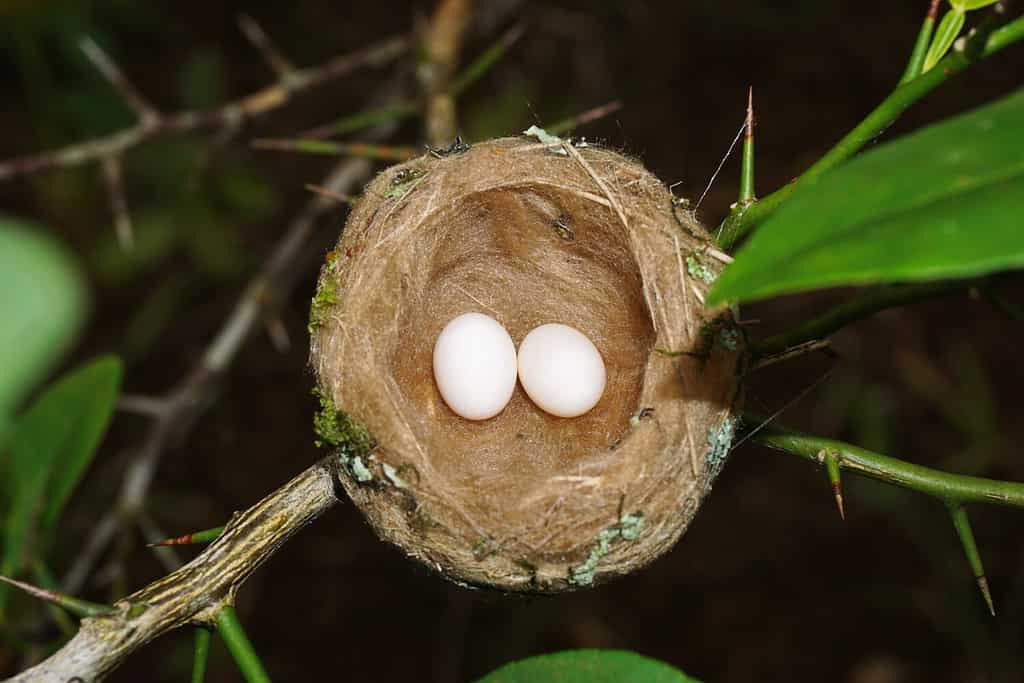
Hummingbirds build nests that are about the size of half of a chicken eggshell.
©Damsea/Shutterstock.com
One of the best ways people can help aid hummingbirds is by providing them with resources before they migrate. People can put up feeders filled with nectar and birdbaths to provide food and water for the birds. In Mississippi, if you put your hummingbird feeder up at the end of February, the first birds to arrive will have something to eat. This will help them quickly recover, so they can breed successfully.
Additionally, people should avoid using pesticides or other chemicals in their gardens that may be harmful to hummingbirds, as these chemicals can disrupt their metabolism or make them sick.
Finally, it is important to create a safe place for the birds to rest during migration season so that they are not exposed to predators or other risks. This can be done by planting native flowers in the garden that hummingbirds are attracted to, as well as leaving some of the plants uncut until after the migration season is over. Hummingbirds build their nests in trees or shrubs 10-30 feet off the ground, so keep your eyes peeled.
By taking these steps and providing a safe environment for hummingbirds before, during, and after their migration, people will be doing their part to help protect these beautiful birds and ensure they have successful journeys each year!
Plants That Attract Hummingbirds in Mississippi
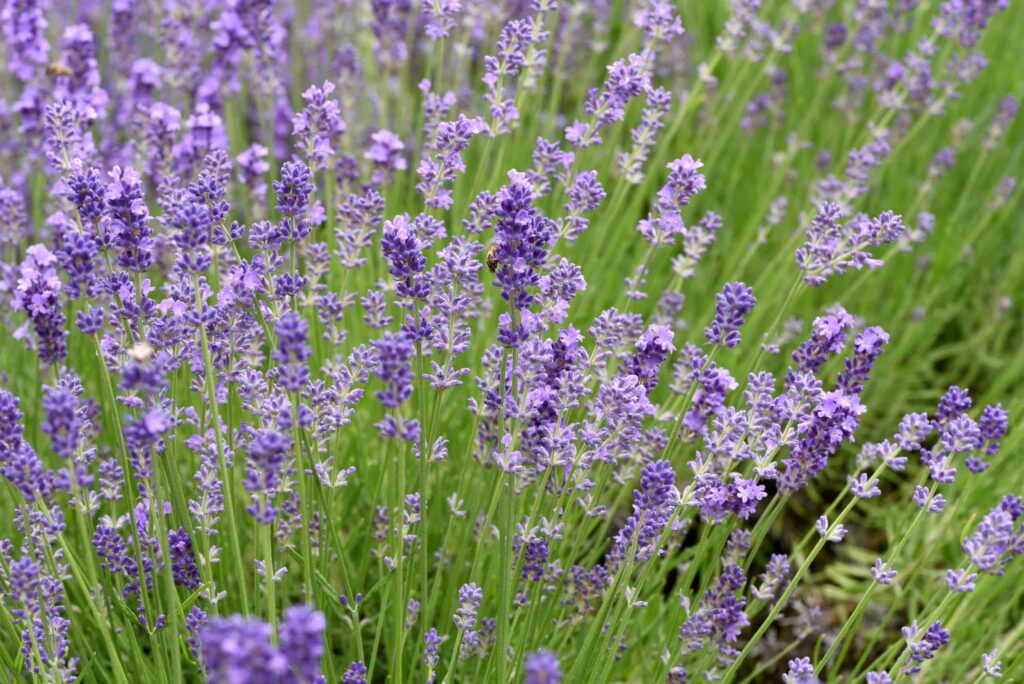
Lavender attracts pollinators of all types.
©Manfred Ruckszio/Shutterstock.com
One of the best ways to help hummingbirds thrive is to have a garden overflowing with nectar-rich flowers. Here are a few plants that grow well in Mississippi and taste delicious to a hummingbird.
Honeysuckle
Honeysuckle is a beautiful, fast-growing flowering vine that is loved by hummingbirds. It has clusters of fragrant yellow, orange, or pink flowers that bloom in the spring and summer. Hummingbirds love the nectar-rich flowers and often flock to the plants for a meal. Growing honeysuckle in Mississippi is relatively easy – they prefer full sun and well-drained soil. Once established, they can thrive with minimal care and attention. Honeysuckle is an excellent addition to any garden, providing a great spot for hummingbirds to visit!
Bee Balm
Bee balm is an attractive flower that comes in a variety of colors, including red, pink, and white. It has a lovely tubular shape and a sweet smell that attracts hummingbirds. Hummingbirds love bee balm because it provides them with an abundant source of nectar and pollen. Growing bee balm in Mississippi is easy and can be done in most soil types. It prefers full sun and regular watering to ensure healthy blooms. Bee balm is an excellent choice for Mississippi gardeners who want to attract beautiful hummingbirds.
Trumpet Creeper
The trumpet creeper is a perennial vine with brilliant orange-red trumpet-shaped flowers. It grows in a wide range of soils, from sand to clay, making it an extremely versatile plant. Its deep green foliage is attractive throughout the growing season, and it can reach heights of up to 30 feet. Hummingbirds love trumpet creepers because of their sweet nectar and bright, colorful flowers.
In Mississippi, grow trumpet creeper in full sun to partial shade. It thrives in moist, well-drained soil and can tolerate some drought. To propagate trumpet creeper, simply collect seeds from the mature pods, and sow them in the fall for germination the following spring.
Cardinal Flower

The tiny tubular-shaped blooms of cardinal flowers are easy for hummingbirds to access.
©iStock.com/laroy lindsey
The cardinal flower is an attractive addition to the garden, boasting brilliant scarlet blooms that stand atop tall, wiry stems. Hummingbirds are particularly attracted to this flower due to the copious amounts of nectar it produces.
To enjoy these blooms in Mississippi, it is best to plant the cardinal flower in a semi-shaded area with moist soil. It can also thrive in full sun or partial shade with regular watering. The flower is a perennial, so it will come back year after year with no need for replanting. Planting a few seeds in the spring and providing consistent moisture will ensure a beautiful display of cardinal flowers in the summer.
Red Columbine
Red columbine is a beautiful flower that grows abundantly in gardens across the United States. It has a unique look with its bell-shaped red blooms and delicate green foliage. The long spurs of the petals give the flower an elegant appearance. Hummingbirds love the red columbine for its sweet nectar and its bright color.
Growing red columbine in Mississippi is fairly easy. It prefers moist, well-drained soil and partial shade. Plant it in early spring, and it will bloom in late spring or early summer. Make sure to give it enough room to spread out. Deadheading will help encourage more blooms. With the right care, you could enjoy a beautiful display of red columbine in your garden.
Blue Sage
Blue sage is an attractive, drought-tolerant herbaceous perennial that adds a burst of color to Mississippi gardens. Its long stems have many deep blue flowers and aromatic gray-green foliage. Hummingbirds are attracted to the bright blue flowers, which provide abundant nectar and pollen.
To grow blue sage in Mississippi, choose a site with well-draining soil and full sun. Plant in the spring or fall, and water regularly until the plants are established. Once established, blue sage can tolerate the heat and drought of Mississippi summers. Trim the stems back after bloom to encourage new growth, and divide every two to three years to keep the plants vigorous and blooming.
Petunia

Colorful petunias are a fast and affordable annual plant to attract pollinators.
©Deniss Grigorjevs/Shutterstock.com
Petunias are beautiful flowers that come in a wide variety of colors. They are known for their bright, vibrant petals and lush foliage. The flowers are a popular choice for hummingbirds, which are attracted to their sweet nectar.
In order to grow petunias in Mississippi, it is important to select the right variety for the climate. Make sure to choose varieties that are heat-tolerant and can withstand humid conditions. Plant the seeds in rich, well-draining soil in a sunny spot and water regularly. With proper care, you can enjoy a profusion of petunias in your garden. They look especially beautiful in hanging baskets.
Daylily
Daylilies are exquisite flowers with vibrant colors and soft petals. They come in many different hues of yellow, orange, red, pink, and purple. The flowers usually last for a day, but they are replaced by new blooms each day. This makes them a beautiful addition to any garden.
Hummingbirds love daylilies because they are full of nectar. The flowers’ shape and size make it easy for the birds to access the nectar and feed.
To grow daylilies in Mississippi, make sure to plant them in well-drained soil. Daylilies like full sun, so make sure they get plenty of direct sunlight throughout the day. Water the plants regularly, especially during dry spells. Deadhead the flowers regularly to encourage continuous blooming. With proper care and maintenance, daylilies will thrive in Mississippi.
Zinnia
Zinnias are bright and beautiful annual flowers that provide a burst of color to any garden. They come in a variety of colors, including red, pink, yellow, purple, and white. The petals are full and round, and the leaves are long and serrated.
Hummingbirds love zinnias because of their sweet nectar. The flowers also act as a great source of food for other pollinators, like butterflies and bees.
To grow zinnias in Mississippi, start by planting seeds in early spring. When planting, make sure to keep the soil moist and make sure the plants get plenty of sunlight. Once the plants have grown, be sure to water them regularly and apply fertilizer. With the right conditions, zinnias will bloom throughout the summer and into the fall.
Thank you for reading! Have some feedback for us? Contact the AZ Animals editorial team.

